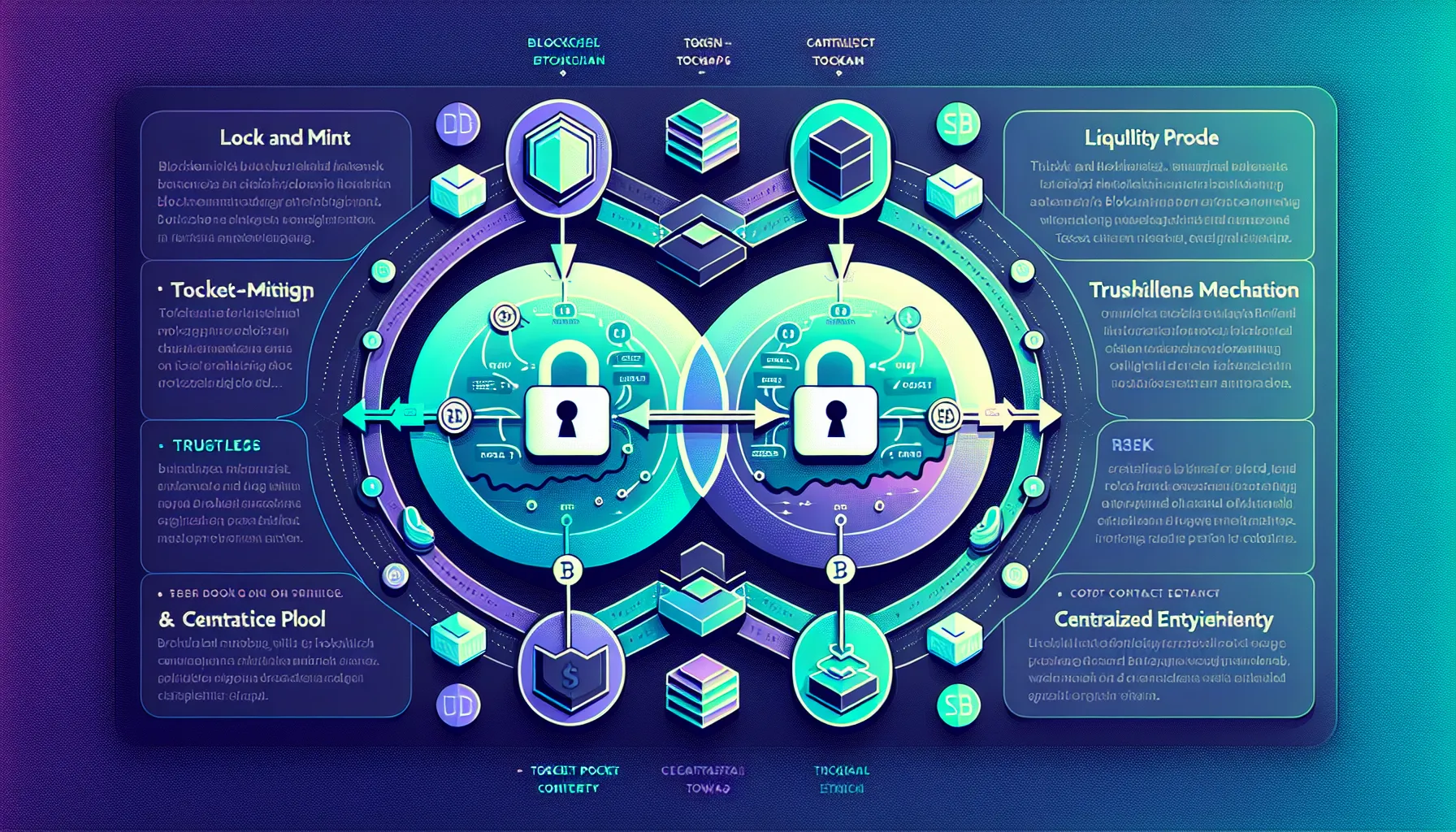The blockchain landscape has evolved into a sprawling network of independent ecosystems, Ethereum, Binance Smart Chain, Polygon, Avalanche, and dozens more. Yet these networks don’t naturally communicate with one another, creating fragmented liquidity and limiting users’ ability to move assets freely. Enter crypto bridges: the infrastructure that enables tokens and data to flow across chains. For traders, investors, and DeFi enthusiasts, choosing the right bridge can mean the difference between seamless transactions and costly delays, or worse, security breaches. This article ranks the top crypto bridges by three critical dimensions: speed, cost, and reliability. Whether one is chasing arbitrage opportunities, minimising fees, or prioritising security above all else, understanding how these bridges stack up is essential for navigating today’s multichain world.
Key Takeaways
- Crypto bridges enable seamless transfer of assets across blockchain networks, with over $2 billion lost to bridge hacks in 2022, making security evaluation critical.
- Top crypto bridges ranked by speed include Synapse Protocol, Hop Protocol, and Stargate Finance, which complete transfers in under two minutes.
- Multichain and Across Protocol are the most cost-effective crypto bridges, typically charging fees under 0.1% with minimal gas costs.
- Axelar Network and Wormhole lead in reliability and security, employing proof-of-stake validators and distributed trust models to protect user assets.
- Stargate Finance offers the best overall balance across speed, cost, and reliability for users navigating the multichain ecosystem.
- Choosing the right crypto bridge depends on prioritising speed for arbitrage, minimising fees for frequent transfers, or maximising security for large transactions.
What Are Crypto Bridges and Why Do They Matter?

Crypto bridges are protocols that help the transfer of digital assets, cryptocurrencies, tokens, NFTs, or even data, between different blockchain networks. Think of them as connective tissue in an otherwise disconnected ecosystem. Without bridges, users would be locked into single chains, unable to tap into DeFi platforms, NFT marketplaces, or yield opportunities on other networks.
Bridges operate through various mechanisms. Some use lock-and-mint models, where assets are locked on the source chain and wrapped tokens are minted on the destination chain. Others employ liquidity pools on both sides, swapping native tokens without wrapping. Then there are trustless bridges relying on smart contracts and validators, versus custodial bridges managed by centralised entities.
Why do they matter? Interoperability is the backbone of a truly decentralised financial system. Bridges enable capital efficiency, allowing users to deploy assets where yields are highest or transaction costs lowest. They also foster innovation by letting developers build cross-chain applications. But, bridges have become prime targets for exploits, over $2 billion was lost to bridge hacks in 2022 alone. This makes evaluating bridges not just a matter of convenience, but of risk management.
Key Criteria for Evaluating Crypto Bridges
Selecting a crypto bridge isn’t a one-size-fits-all decision. Users must weigh multiple factors depending on their priorities. The three pillars, speed, cost, and reliability, form the foundation of any sound evaluation.
Transaction Speed and Finality
Speed is measured in two parts: how quickly a transaction is initiated and confirmed on the source chain, and how long it takes for the bridged asset to appear on the destination chain. Some bridges complete transfers in under a minute, while others may take ten minutes or longer, especially when waiting for multiple block confirmations to ensure finality.
Finality matters because it represents the point at which a transaction is irreversible. Bridges that prioritise speed may sacrifice finality checks, exposing users to reorg risks. Conversely, bridges that wait for deep finality offer greater security but slower throughput. For traders executing time-sensitive arbitrage, every second counts. For long-term holders moving assets between wallets, a few extra minutes may be negligible.
Cost Efficiency and Fee Structures
Bridge fees vary widely and often consist of multiple components: base protocol fees, network gas fees on both chains, and sometimes liquidity provider fees. A bridge might advertise low protocol fees but still cost significantly if it operates on high-gas networks like Ethereum during peak times.
Some bridges employ dynamic fee models that adjust based on liquidity depth or network congestion. Others charge flat rates. It’s crucial to calculate the total cost, including slippage for liquidity pool-based bridges, before committing to a transfer. For small transactions, high fees can erode value quickly, while large transfers may benefit from percentage-based models.
Security and Reliability Measures
Reliability encompasses both uptime and security. A bridge might be fast and cheap, but if it’s frequently offline or has a history of exploits, it’s not worth the risk. Key security features include multi-signature wallets, audited smart contracts, bug bounty programmes, and decentralised validator networks.
Centralised bridges, while often faster, introduce custodial risk. Decentralised bridges distribute trust across validators or rely on cryptographic proofs, but may suffer from slower processing or higher complexity. Users should also consider insurance options and track records, bridges that have operated for years without incident generally inspire more confidence than newer, untested protocols.
Top Crypto Bridges for Speed
When speed is the priority, whether for arbitrage, time-sensitive DeFi positions, or simply impatience, certain bridges stand out.
Synapse Protocol consistently ranks among the fastest, often completing cross-chain swaps in under two minutes. It uses liquidity pools on both sides, which means no waiting for minting or burning processes. Synapse supports a wide range of chains including Ethereum, Arbitrum, Optimism, and Avalanche, making it a versatile option for speed-focused users.
Hop Protocol is another speed champion, particularly for Ethereum Layer 2 transfers. By using automated market makers (AMMs) and hToken intermediaries, Hop achieves near-instant bridging between rollups like Arbitrum and Optimism. While its speed advantage is most pronounced within the Ethereum ecosystem, it’s less competitive for bridges involving non-EVM chains.
Stargate Finance, built on LayerZero, leverages a unified liquidity model that allows instant guaranteed finality. Users can bridge stablecoins and native assets across chains in seconds, with the protocol handling composability natively. Stargate’s speed doesn’t come at the expense of security, it uses decentralised relayers and oracles to validate cross-chain messages.
For those bridging between Binance Smart Chain and Ethereum, cBridge by Celer Network offers impressive throughput, often completing transfers in under three minutes. It combines state channel technology with liquidity pools, enabling rapid settlement without compromising on decentralisation.
Most Cost-Effective Crypto Bridges
Minimising costs is crucial, especially for frequent bridgers or those moving smaller amounts. Fee structures can make or break the economics of cross-chain transactions.
Multichain (formerly Anyswap) is widely regarded as one of the most cost-effective options, particularly for bridging between EVM-compatible chains. Its fees are typically a flat 0.1% with a minimum charge, making it economical for both small and large transfers. Multichain supports over 80 chains, giving users flexibility to find the cheapest route.
Across Protocol uses a novel model where relayers front capital to users instantly, then settle later via optimistic verification. This results in lower gas costs since users don’t pay for expensive cross-chain message passing. Across charges minimal fees, often under 0.1%, and is particularly cost-effective for Ethereum L2 to L2 bridging.
Connext operates on a similar principle, using liquidity pools and routers to minimise on-chain operations. By batching transactions and leveraging optimistic rollups, Connext keeps fees competitive. It’s particularly affordable for smaller transfers, where flat-fee bridges become prohibitively expensive.
For those bridging stablecoins specifically, Stargate again deserves mention. Its unified liquidity model reduces slippage and fees, often making it cheaper than traditional AMM-based bridges. Users moving USDC or USDT between major chains frequently find Stargate offers the best price-to-speed ratio.
It’s worth noting that cost-effectiveness varies with network conditions. Bridges operating on low-fee chains like Polygon or Arbitrum inherently cost less than those requiring transactions on Ethereum mainnet. Savvy users often route through cheaper intermediary chains to reduce total costs.
Most Reliable and Secure Bridges
Security breaches have plagued the bridge sector, making reliability a non-negotiable criterion for risk-conscious users.
Wormhole, even though suffering a high-profile exploit in 2022, has since undergone extensive security overhauls and remains one of the most reliable bridges for cross-chain messaging. Backed by Jump Crypto, Wormhole employs a network of 19 guardian validators and has implemented rigorous audits and bug bounties. It supports a wide range of chains including Ethereum, Solana, Terra, and BNB Chain, with a strong focus on security-first architecture.
Axelar Network stands out for its security model, which uses validators staked with significant capital and operates on a proof-of-stake consensus mechanism. Axelar’s architecture is designed for composability, allowing developers to build secure cross-chain applications. It has maintained a clean security record and undergoes regular third-party audits.
Multichain (mentioned earlier for cost) also ranks highly for reliability. It has processed billions in volume since 2020 and uses a Secure Multi-Party Computation (SMPC) model where no single party controls private keys. This distributed trust model reduces single points of failure, though it does introduce some centralisation compared to fully trustless bridges.
Synapse Protocol deserves another mention here. Beyond its speed, Synapse has maintained robust uptime and security standards. It employs multi-signature controls, regular audits by firms like Quantstamp and Certik, and has a responsive team that quickly addresses vulnerabilities.
Users prioritising security should also look for bridges with insurance coverage or compensation funds. Some protocols maintain treasury reserves specifically to reimburse users if exploits, adding an extra layer of protection.
Overall Best Crypto Bridges: Balanced Performance
For users seeking a balance across all three dimensions, speed, cost, and reliability, certain bridges consistently deliver well-rounded performance.
Stargate Finance arguably offers the best overall package. It’s fast (often under two minutes), cost-effective (low fees and minimal slippage), and secure (built on LayerZero’s battle-tested infrastructure). Stargate’s unified liquidity approach means users get instant guaranteed finality without the fragmentation seen in other bridges. It supports major chains including Ethereum, Avalanche, Polygon, Arbitrum, Optimism, and BNB Chain.
Synapse Protocol is another top contender for balanced performance. Its speed is excellent, fees are competitive, and its security track record is solid. Synapse’s user interface is intuitive, making it accessible for both beginners and advanced users. The protocol’s wide chain support and active development community add to its appeal.
Celer cBridge combines decentralisation with practical performance. It’s reasonably fast, offers competitive fees (typically 0.04% to 0.1%), and has maintained strong security through its State Guardian Network. Celer’s liquidity model ensures reliability even during high-volume periods, and it supports over 40 chains.
Hop Protocol, while primarily focused on Ethereum and its Layer 2s, delivers exceptional performance within that ecosystem. For users operating predominantly in the Ethereum sphere, Hop offers an ideal balance of speed (near-instant for L2-to-L2), reasonable costs, and robust security.
These bridges have proven themselves through sustained operation, significant transaction volumes, and active security measures. They’re suitable for a wide range of use cases, from casual portfolio rebalancing to professional trading operations.
How to Choose the Right Bridge for Your Needs
Selecting the optimal bridge requires honest assessment of one’s priorities and use case.
For high-frequency traders and arbitrageurs, speed trumps all else. Synapse, Hop, and Stargate should top the list. Every minute of delay represents potential profit loss, so these users should be willing to accept slightly higher fees for faster execution.
Cost-conscious users moving assets infrequently or in smaller amounts should prioritise Multichain, Across, or Connext. It’s worth spending extra time to compare fee estimates across multiple bridges, the savings can be substantial, especially when bridging during off-peak hours to minimise gas costs.
Those who prioritise security above all, particularly when moving significant sums, should lean towards Axelar, Wormhole, or Multichain. These users might accept slower speeds and higher costs in exchange for robust security infrastructure. It’s also wise to split large transfers across multiple transactions or even multiple bridges to reduce risk exposure.
Chain coverage matters too. Users operating across diverse ecosystems need bridges like Multichain or Wormhole that support dozens of chains. Those focused on Ethereum and its L2s can optimise by using specialised bridges like Hop.
Finally, consider the asset type. Stablecoin bridging often benefits from specialised bridges like Stargate, which minimises slippage. NFT bridging requires bridges with specific NFT support, which not all protocols offer.
Practical advice: always do a small test transaction first. Bridges can behave differently under varying network conditions, and there’s no substitute for firsthand experience. Monitor bridge status pages and community channels for real-time information about performance or issues.
Conclusion
The crypto bridge landscape is dynamic and competitive, with protocols continuously improving performance across speed, cost, and reliability. No single bridge excels universally in all three dimensions, trade-offs remain inherent to the technology.
For most users seeking balanced performance, Stargate Finance and Synapse Protocol represent the strongest all-round options. Speed-focused users should gravitate towards Synapse and Hop, while cost-conscious bridgers will find Multichain and Across offer the best value. Security-first users can rely on Axelar and Wormhole’s robust infrastructure.
The bridge sector continues to mature, with new protocols launching and existing ones enhancing their offerings. As interoperability becomes increasingly central to blockchain adoption, expect to see further innovations in security models, fee structures, and transaction speeds. For now, users armed with knowledge of how these bridges compare can navigate the multichain ecosystem with confidence, moving assets efficiently whilst managing risks appropriately. The key lies in matching bridge characteristics to individual needs rather than blindly following popularity rankings.
Frequently Asked Questions
What is a crypto bridge and how does it work?
A crypto bridge is a protocol that enables the transfer of digital assets between different blockchain networks. They typically use lock-and-mint models, where assets are locked on one chain and wrapped tokens are minted on another, or liquidity pools that swap native tokens directly across chains.
Which crypto bridge is fastest for cross-chain transfers?
Synapse Protocol is consistently amongst the fastest, completing cross-chain swaps in under two minutes using liquidity pools. Hop Protocol also excels for Ethereum Layer 2 transfers, achieving near-instant bridging, whilst Stargate Finance offers instant guaranteed finality across multiple chains.
What are the typical fees for using crypto bridges?
Bridge fees vary significantly, typically ranging from 0.04% to 0.1% of transaction value, plus network gas fees on both chains. Multichain charges around 0.1% with a minimum fee, whilst Across Protocol often charges under 0.1%, making them cost-effective options.
Are crypto bridges safe to use in 2025?
Security varies by protocol. Bridges like Axelar, Wormhole, and Multichain employ robust security measures including validator networks, multi-signature controls, and regular audits. However, bridges remain targets for exploits, so users should prioritise bridges with proven track records and always test with small amounts first.
Can I bridge NFTs between different blockchains?
Yes, certain crypto bridges support NFT transfers between chains, though not all protocols offer this functionality. You’ll need to verify that your chosen bridge specifically supports NFT bridging, as most bridges primarily focus on fungible tokens and stablecoins.
What is the difference between custodial and trustless crypto bridges?
Custodial bridges are managed by centralised entities that control users’ assets during transfers, offering faster processing but introducing security risks. Trustless bridges rely on smart contracts and decentralised validators, distributing trust across networks for enhanced security, though sometimes with slower processing times.








